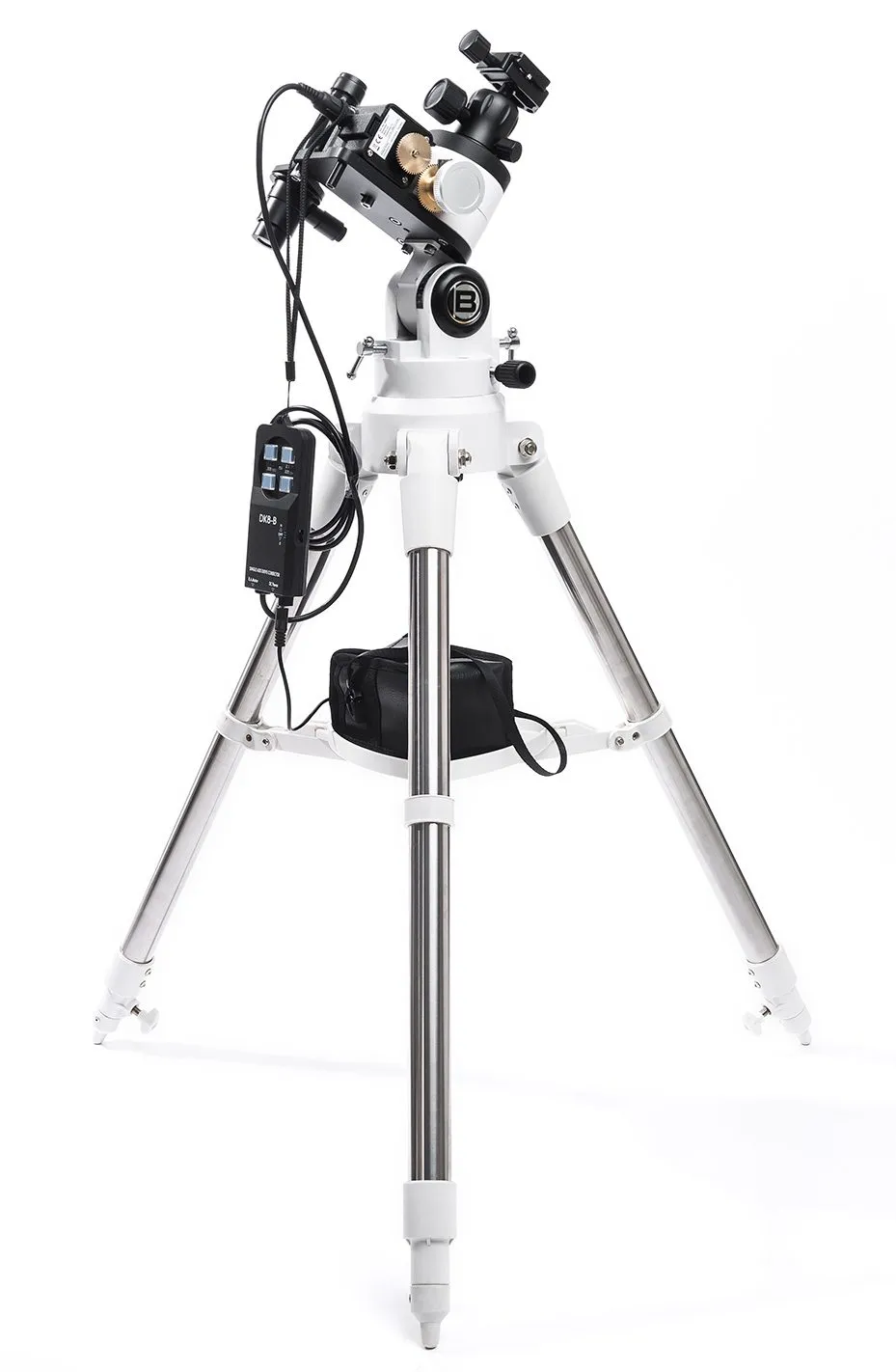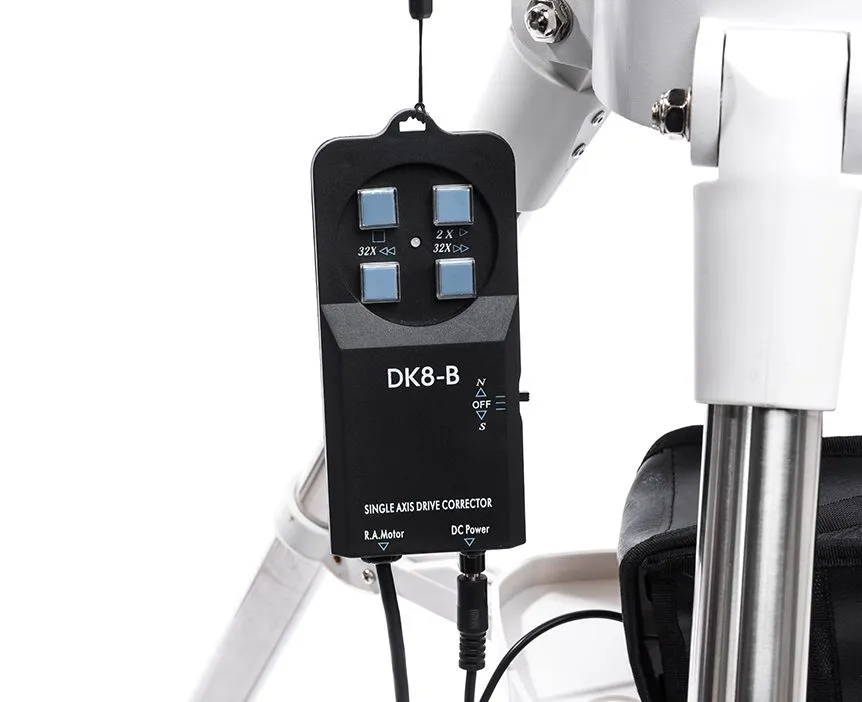There are so many tracking mounts for taking wide-field and telephoto long exposures of the night sky, one would think the market might be saturated.Yet Bresser has joined in with their Photo Mount and we were keen to see how it compared with others we have tested.
The Photo Mount can be purchased with or without a dedicated tripod/polar wedge, so if you already own a good tripod you can get the version without and save some money.
However, here we review the complete package which includes the tripod/polar wedge, an illuminated polar finder scope, polar sighting tube, hand controller, ball head socket and a power pack that takes eight D-type batteries.
Setting up was straightforward and took little time as the tripod and polar wedge came preassembled. The polar scope attached to the base of the mount and, if needed, could be adjusted so as to not interfere with any camera when fitted.
The Photo Mount head attached to the polar wedge and then the ball head socket which has a quick-release saddle plate screwed in place ready for a camera.

Weighty issue
The suggested maximum load of camera and lens is 2.5kg and our Canon 50D DSLR and 100–400mm EOS lens were spot on that weight, while changing to our 70–300mm lens brought the weight down to 1.5kg.
The camera with its standard 18–55mm lens was 1kg, so all the weight combinations worked out as either just on, or well within, the load capacity limit.
Our camera was attached to the ball head socket via its quick-release plate, ready for our first night of imaging.
It should be noted that during our first attempts at reviewing this product we discovered a significant tracking error, the cause of which was identified as the gear ratio being incorrectly set up, even with wide-field lenses.
Telescope House liaised with Bresser, who had just discovered that a second production run also had gear ratio issues.A new set of gears was sent out to us and installed quite easily.
Our first imaging run with the new gears confirmed the Photo Mount was now working perfectly.
Once polar-aligned (see ‘Fine alignment’ box), we began imaging with our 18–55mm lens set at 18mm. This allowed us to take in Orion, Taurus, most of Auriga and Gemini.
We achieved 10-minute, 20-minute and 30-minute exposures with no star trailing at all, although the latter did suffer from a dewed-up lens.
We achieved an excellent result when we swapped to our 70–300mm lens set at 70mm and aimed at the southern half of Orion, which gave 15 minutes with no trailing.
Once we increased the size of the lens, we could make slight adjustments by using the hand controller, with its 2x and 32x forward and 32x backward slewing controls. This helped for centring the view.
The small green light on the controller was a little bright, but not too troublesome for our night vision.
Bresser recommends using up to a 200mm lens, so we set the 70–300mm at 200mm and still achieved five-minute exposures of the Pleiades (M45) star cluster in Taurus with no trailing.
Pushing the lens to 300mm and aiming at the Sword of Orion, we still managed three-minute exposures with no trailing.
However, swapping to our EOS 100–400mm lens pushed the load capacity to the maximum, and while at a 100mm focal length we could achieve three-minute exposures with barely any sign of trailing, the additional weight clearly took the mount to its limit.
We did find that with the heaviest load there was a little slippage in the ball head over long periods, but this is a very minor niggle in what is a good system.
Overall, this mount is aimed primarily at wide-field and medium telephoto astrophotography, and for this it really delivers. We were impressed with its performance and found it one of the best we’ve tested in the field.

Fine alignment
For any equatorial tracking mount, the key to great astrophotos is accurate polar alignment.
Bresser’s Photo Mount has two ways of achieving polar alignment: a rough sighting tube for a quick alignment and a more accurate polar alignment scope.
For very wide-field astrophotography, the rough polar alignment is sufficient for several minutes of tracking before any star trailing occurs.
If you increase the focal length or length of exposure, the best option is to use the polar scope.
The polar scope has an etched view of the Great Bear and Cassiopeia, and you can rotate the scope in its holder to match their orientation.
The clever bit is that there is a line with a gap to place Polaris in, along with a second line where you can position Delta (d) Ursae Minoris.
Get both in their allotted spots and you have excellent polar alignment, allowing the use of longer exposures or larger lenses.We found this to be one of the best ways to polar align in our several years of reviewing equipment.
Photo Mount and gears
The Photo Mount is a solid unit that attaches to the polar wedge via two ¼-inch screws.
The rotary knob can be used to manually fine adjust the right ascension (RA) when loosened, then tightened to engage the motors for tracking.
The RA clamp is used for larger-scale adjustment.
Altaz adjustments
Adjustments for altitude and azimuth are easy.There is a bubble level to ensure the tripod is level and the polar wedge has a latitude scale that enables a rough initial set-up before fine adjustments are made.
Power pack
Power is provided by eight D-type batteries (not included), held in a soft case and connected to the hand controller.In the field we had no issues with power loss over several nights’ usage. Bresser estimates that you should get 50 hours before replacement batteries are needed.
Ball head
The supplied Bresser ball head with quick-release saddle plate worked well. It has two knobs for adjustment: one for rotating the whole ball head around its base and the other for adjusting the tilt of the camera.With heavy lenses there was a slight slippage, but it was minor.
Hand controller
The DK8-B hand controller provides power and control to the RA motor.The four buttons pause the motor and make 2x and 32x forward and backward fine adjustments.
Vital stats
- Price: £310
- Load capacity: 2.5kg
- Tracking rate: Sidereal, Northern and Southern Hemisphere
- Polar scope: Illuminated polar scope
- Extras: Power pack case, hand controller with 2x/32x slewing adjustment, accessories tray, sighting tube
- Total weight: 4.5kg
- Supplier: Telescope House
- Tel: 01342 837098
- www.telescopehouse.com
This review originally appeared in the April 2019 issue of BBC Sky at Night Magazine
